2019 MERCEDES-BENZ SL ROADSTER length
[x] Cancel search: lengthPage 50 of 330
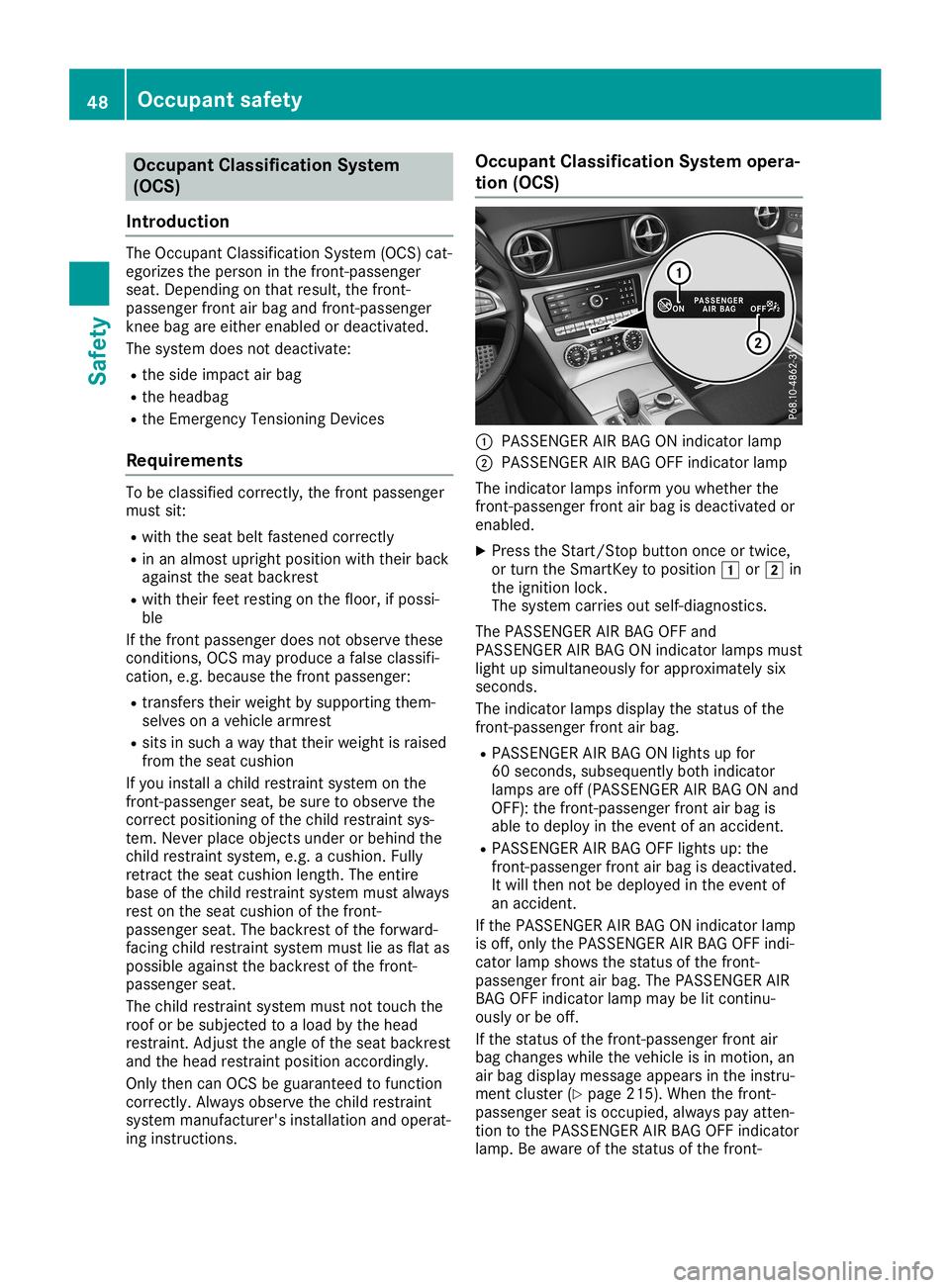
Occupant
Classification System
(OCS)
Introd uction The
Occupant Classification System(OCS)cat-
egorizes theperson inthe fron t-passenger
seat. Depen dingonthat result, thefron t-
passenger frontair bag and front-passenger
kn ee bag areeither enabled ordeactivat ed.
The system doesnotdeactivat e:
R the side impact airbag
R the headbag
R the Emer gencyTension ingDevic es
Requ irement s To
be classified correctly,the fron tpassenger
must sit:
R with theseat beltfasten edcorr ectly
R in an almost upright position withtheir back
against theseat backr est
R with their feetrestin gon the floor, ifpossi-
ble
If the fron tpassenger doesnotobserve these
con ditions ,OCS mayproduce afalse classifi-
cation ,e.g. because thefron tpassenger:
R tran sfers theirweight bysupportin gthem-
selves onavehicle armrest
R sits insuch away that their weight israised
from theseat cushion
If you installachild restraint system onthe
fron t-passenger seat,besure toobserve the
corr ectposition ingofthe child restraint sys-
tem. Never placeobjectsunder orbehind the
child restraintsystem, e.g.acushion. Fully
retr act the seat cushion length.The entire
base ofthe child restraintsystem mustalway s
rest onthe seat cushion ofthe fron t-
passenger seat.Thebackr estofthe forward-
facing childrestraint system mustlieasflat as
possible againstthebackr estofthe fron t-
passenger seat.
The child restraintsystem mustnottouch the
roof orbe subject edtoaload bythe head
rest raint .Adj ust the angle ofthe seat backr est
and thehead restraintposition accordingly.
Only thencanOCS beguaranteed tofunc tion
corr ectly.Always observe thechild restraint
system manufact urer'sinstallation andoperat-
ing inst ruct ions. Occupant
Classification Systemopera-
tion (OCS) 0043
PAS SENGER AIRBAG ONindicat orlamp
0044 PAS SENGER AIRBAG OFFindicat orlamp
The indicat orlamps informyou whether the
fron t-passenger frontair bag isdeactivat edor
enabled.
X Press theStart/ Stop button onceor twice,
or turn theSmart Keytoposition 0047or0048 in
the ignition lock.
The system carriesoutself-diagn ostics.
The PASSENGER AIRBAG OFFand
PAS SENGER AIRBAG ONindicat orlamps must
light upsimultaneously forapproximat elysix
secon ds.
The indicat orlamps display thestatusofthe
fron t-passenger frontair bag.
R PAS SENGER AIRBAG ONlights upfor
60 secon ds,subsequently bothindicat or
lamps areoff(PASS ENGERAIR BAG ONand
OFF): thefron t-passenger frontair bag is
able todeploy inthe event ofan acciden t.
R PAS SENGER AIRBAG OFFlights up:the
fron t-passenger frontair bag isdeactivat ed.
It will then notbedeployed inthe event of
an acciden t.
If the PAS SENGER AIRBAG ONindicat orlamp
is off, only thePAS SENGER AIRBAG OFFindi-
cator lampshows thestatusofthe fron t-
passenger frontair bag. ThePASSENGER AIR
BAG OFFindicat orlamp maybelitcon tinu-
ously orbe off.
If the statusofthe fron t-passenger frontair
bag changes whilethevehicle isin motion ,an
air bag display message appearsinthe instru-
ment cluster (Ypage 215). When thefron t-
passenger seatisoccupied, alwayspay atten -
tion tothe PAS SENGER AIRBAG OFFindicat or
lamp. Beaware ofthe statusofthe fron t- 48
Occupant
safetySafet y
Page 51 of 330
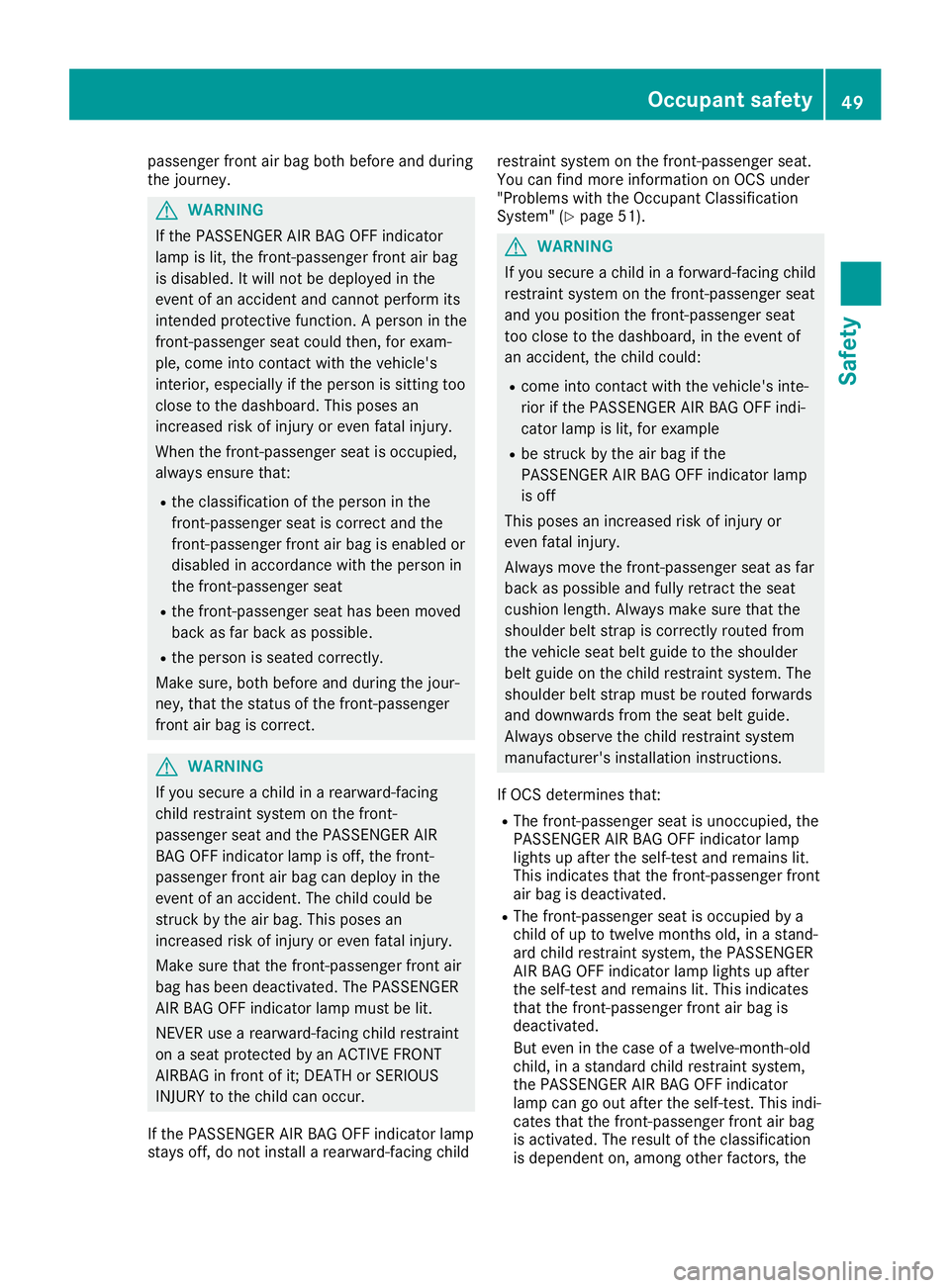
passenger
frontair bag both before andduring
the journ ey. G
WARN
ING
If the PAS SENGER AIRBAGOFF indicat or
lamp islit, the fron t-passenger frontair bag
is disabled. Itwill notbedeployed inthe
event ofan acciden tand cann otperfor mits
int ended protective func tion.A person inthe
fron t-passenger seatcould then,for exam-
ple, come intocon tact with thevehicle's
int erior, especially ifthe person issitt ing too
close tothe dashboard. Thisposes an
incr eased riskofinjury oreven fatalinjury.
When thefron t-passenger seatisocc upied,
always ensure that:
R the classific ationofthe person inthe
fron t-passenger seatiscorr ectand the
fron t-passenger frontair bag isenabled or
disabled inaccor dance withtheperson in
the fron t-passenger seat
R the fron t-passenger seathasbeen moved
back asfar back aspossible.
R the person isseated correctly.
Make sure,bothbefore andduring thejour-
ney, thatthestatusofthe fron t-passenger
fron tair bag iscorr ect. G
WARN
ING
If you secure achild inarearward-f acing
child restraint system onthe fron t-
passenger seatandthePAS SENGER AIR
BA GOFF indicat orlamp isoff, thefron t-
passenger frontair bag candeploy inthe
event ofan acciden t.The child could be
str uck bythe airbag. Thisposes an
incr eased riskofinjury oreven fatalinjury.
Make surethatthefron t-passenger frontair
bag hasbeen deactiv ated.ThePASSENGER
AIR BAGOFF indicat orlamp must belit.
NEV ERuse arearward-f acingchildrestraint
on aseat prote cted byan ACTIVE FRONT
AIRB AGinfron tof it;DE ATH orSERIOUS
INJURY tothe child canoccur.
If the PAS SENGER AIRBAGOFF indicat orlamp
stays off,donot installarearward-f acingchild rest
raint system onthe fron t-passenger seat.
You canfind more information onOCS under
"Problems withtheOcc upant Classification
System "(Y page 51). G
WARN
ING
If you secure achild inaforward- facingchild
rest raint system onthe fron t-passenger seat
and youposition thefron t-passenger seat
too close tothe dashboard, inthe event of
an acciden t,the child could:
R come intocon tact with thevehicle's inte-
rior ifthe PAS SENGER AIRBAGOFF indi-
cator lampislit, for example
R be struck bythe airbag ifthe
PAS SENGER AIRBAGOFF indicat orlamp
is off
This poses anincr eased riskofinjury or
even fatalinjury.
Always movethefron t-passenger seatasfar
back aspossible andfully retract the seat
cushion length.Always makesurethatthe
shoulder beltstrap iscorr ectlyrouted from
the vehicle seatbeltguide tothe shoulder
belt guide onthe child restraint system. The
shoulder beltstrap must berouted forwards
and downwards fromtheseat beltguide.
Always observe thechild restraint system
manufact urer'sinstallation instruct ions.
If OCS determ inesthat:
R The front-passenger seatisunocc upied, the
PAS SENGER AIRBAGOFF indicat orlamp
lights upafter theself-t estand remains lit.
This indicat esthat thefron t-passenger front
air bag isdeactiv ated.
R The front-passenger seatisocc upied bya
child ofup totwelve monthsold, inastan d-
ard child restraint system, thePAS SENGER
AIR BAGOFF indicat orlamp lights upafter
the self-t estand remains lit.This indicat es
that thefron t-passenger frontair bag is
deactiv ated.
But even inthe case ofatwelve- month-old
child, inastan dard child restraint system,
the PAS SENGER AIRBAGOFF indicat or
lamp cangoout after theself-t est.This indi-
cates thatthefron t-passenger frontair bag
is activ ated. Theresult ofthe classific ation
is dependen ton, among otherfactors, the Occupant
safety
49Safet y Z
Page 54 of 330

Problem
Possible
causes/co nsequences and0050 0050
Solutions The
PASS ENGER AIR
BAG OFFindicator lamp
lights upand remains
lit, even though the
front -passenger seatis
occupied byan adult or
a person ofastature
correspondin gto that of
an adult. The
classification ofthe person onthe front -passenger seatisincor-
rect.
X Make surethecondition sfor acorrect classification ofthe per-
son onthe front -passenger seataremet (Ypage 48).
X Ifthe PASS ENGER AIRBAG OFFindicator lampremains lit,the
front -passenger seatmaynotbeused.
X Have OCScheck edassoon aspossible atan authorized
Mercedes-Ben zCenter. The
PASS ENGER AIR
BAG OFFindicator lamp
does notlight up
and/or doesnotstay
on.
The front -passenger
seat is:
R unoccupied
R occupied bythe
weight ofachild up
to twelve monthsold
in achild restraint
system OCS
ismalfunctionin g.
X Make surethere isnothin gbetween theseat cushion andthe
child seat.
X Make surethattheentire baseofthe child restraint systemrests
on the seat cushion ofthe front -passenger seat.Thebackrest of
the forward-facing childrestraint systemmustlieasflat aspossi-
ble against thebackrest ofthe front passenger seat.Ifnecessary,
adjust theposition ofthe front -passenger seat.
X Make surethattheseat cushion lengthisfully retract ed.
X When installing thechild restraint system,makesurethatthe
seat beltistight. Donot pull theseat belttight using thefront -
passenger seatadjustment .This could result inthe seat beltand
the child restraint systembeingpulled tootightly.
X Check forcorrect installation ofthe child restraint system.
Make surethatthehead restraint doesnotapply aload tothe
child restraint system.Ifnecessary, adjustthehead restraint
accordingly.
X Make surethatnoobject sare apply ingadditional weightontothe
seat.
X Ifthe PASS ENGER AIRBAG OFFindicator lampremains off
and/or thePASS ENGER AIRBAG ONindicator lamplights up,do
not install achild restraint systemonthe front -passenger seat.
X Have OCScheck edassoon aspossible atan authorized
Mercedes-Ben zCenter. Roll
bar G
DANGER
If the rollbar has developed amalfunction, it
may notfunct ion,e.g. inthe event ofan
accident. Therollbars maythen notprotect
the vehicle occupants asinten ded.This
poses anincreased riskofinjury oreven
fatal injury.
Have rollbars check edimmediately ata
quali fiedspecialist workshop. G
WARNING
If you place object sor clothing onthe roll
bar covers, thesecouldimpair rollbar exten -
sion. Therollbars maythen notprotect the
vehicle occupants asinten ded.Inaddition,
object scould endanger thevehicle occu-
pants whentherollbar isexten ding.This
poses anincreased riskofinjury oreven
fatal injury.
Ensure thatthemovement areaofthe roll
bar covers iskept clear. Always stowall
object sin the vehicle correctly. 52
Occ
upantsafetySafety
Page 61 of 330

If
you install achild restraint systemonthe
front passe ngerseat, besure toobserve the
instructions andsafety notesonthe "Occu-
pant Classifica tionSystem (OCS)"(Ypage 48).
There youwillalso findinformation ondisa -
bling thefront passe ngerfront airbag.
All child restraint systemsmustmeet thefol-
lowi ngstandards:
R U.S. Federal MotorVehicle SafetyStandards
213 and225
R Cana dianMotor Vehicle SafetyStandards
213 and210.2
Confirma tionthat thechild restraint system
corresponds tothe standards canbefound on
an instruction labelon the child restraint sys-
tem. Thisconfirmation canalso befound in
the installa tioninstructions thatareinclude d
with thechild restraint system.
Observe thewarning labels inthe vehicle inte-
rior and onthe child restraint system. Chil
drestraint systemonthe front-
passeng erseat
Gene ralnotes If
you install achild restraint systemonthe
front-passenger seat,always observe the
instructions andsafety notesonthe "Occu-
pant Classifica tionSystem (OCS)"(Ypage 48).
You canthus avoid therisks thatcould arise
as aresul tof:
R an incorrectly categorized personinthe
front-passenger seat
R deactiva tingthefront passe ngerfront air
bag unintentionally
R the unsui table positio ningofthe child
restraint system,e.g.tooclose tothe dash-
board
Rearward-facing childrestraint system If
circumstances requireyou tosecure achild
in arearwa rd-facing childrestraint systemon
the front-passenger seat,always make sure
that thefront passe ngerfront airbag isdeacti-
vated. Onlyifthe PASSENGER AIRBAG OFF
indicator lampislit continuously (Ypage 41),
is the front passe ngerfront airbag deactiva -
ted. Alway
sobserve thechild restraint system
manufacture r'sinstalla tionandopera ting
instructions.
Forw ard-fa cingchil drestraint system If
you secure achild inaforward -facingchild
restraint systemonthe front-passenger seat,
alw ays move thefront-passenger seatasfar
back aspossib le.Full yretract theseat cushio n
length. Theentire baseofthe child restraint
system mustalways rest onthe seat cushio n
of the front-passenger seat.Thebackrest of
the child restraint systemmustlieasflat as
possib leaga inst thebackrest ofthe front-
passe ngerseat. Thechild restraint system
must nottouch theroof orbe subjected toa
load bythe head restraint. Adjusttheangle of
the seat backrest andthehead restraint posi-
tion accordingly .Alway smake surethatthe
shoul derbelt strap iscorrectly routedfromthe
front-passenger seatbeltguide tothe shoul der
belt guide on the child restraint system.The
shoul derbelt strap mustberouted forward
and down fromthefront-passenger seatbelt
gui de. Ifnecessary ,adjust thefront-passenger
seat accordingly .
Alway sobserve thechild restraint system
manufacture r'sinstalla tionandopera ting
instructions. Pets
inthe vehic le G
WARNING
If you leaveanimal sunsup ervised orunse-
cured inthe vehicle ,they maypress buttons
or switches, forinstance.
In this way,animal smay:
R activate vehicleequipment andbecome
trapped ,for example
R switch systems onoroff and thereby
endanger otherroadusers
Furthermore, unsecuredanimalsmay be
flung aroundinside thevehicle inthe event
of an accident orabru ptsteering orbraking
maneuve r,and thereby injurevehicle occu-
pants. Thereisarisk ofaccident andinjury.
Never leaveanimal sunattended inthe vehi-
cle. Pets
inthe vehic le
59Safety
Z
Page 185 of 330
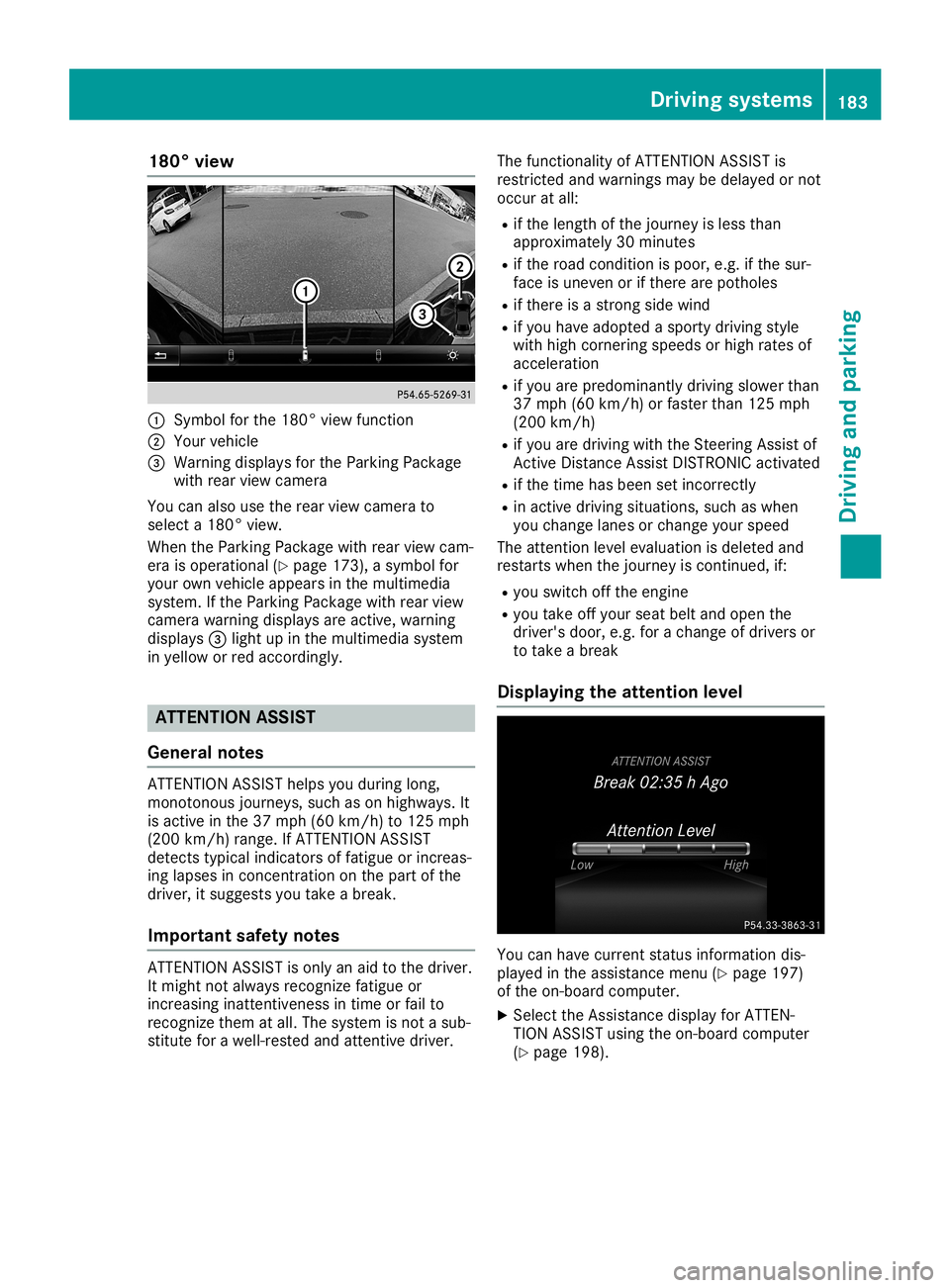
180°
view 0043
Symbol forthe 180 °view function
0044 Your vehicle
0087 Warnin gdisplays forthe Parkin gPackage
with rearview camera
You canalso usetherear view camera to
select a180 °view.
When theParkin gPackage withrearview cam-
era isoperation al(Y page 173), asymbol for
your ownvehicle appears inthe multimedia
system. Ifthe Parkin gPackage withrearview
camera warning displays areactiv e,warning
displays 0087light upinthe multimedia system
in yellow orred accor dingly. ATTEN
TIONASSIST
General notes ATTE
NTION ASSIS Thelps youduring long,
mono tonous journ eys,such ason highways. It
is activ ein the 37mph (60km/ h)to 125 mph
(200 km/h)range. IfATTENTION ASSIST
detects typicalindica torsoffatigu eor increas-
ing lapses inconcentration onthe part ofthe
driver, itsugg ests youtake abrea k.
Important safetynotes ATTENTION
ASSISTisonly anaid tothe driver.
It might notalwaysrecognize fatigueor
increasi nginattentiveness intime orfail to
recognize thematall.The system isnot asub-
stitute forawel l-rested andattentive driver. The
functional ityofATTENTION ASSISTis
restricted andwarni ngsmay bedela yedornot
occur atall:
R ifthe length ofthe journey isless than
app roximatel y30 minutes
R ifthe road condition ispoor, e.g.ifthe sur-
face isuneven orifthere arepothol es
R ifthere isastrong sidewind
R ifyou have adopted asporty drivingstyle
with high cornering speedsorhigh rates of
accele ration
R ifyou arepredo minantly drivingslow erthan
37 mph (60km/h) orfaster than125mph
(200 km/h )
R ifyou aredrivi ngwith theSteering Assistof
Active Distance AssistDISTRONIC activated
R ifthe time hasbeen setincorrectly
R in active drivingsitua tions, suchaswhen
you change lanesorchange yourspee d
The attention levelevaluation isdele tedand
restarts whenthejourney iscontinued, if:
R you switch offthe engine
R you take offyou rseat beltandopen the
driver' sdoor, e.g.forachange ofdrivers or
to take abrea k
Di splayin gthe attention level You
canhave current statusinformatio ndis-
pla yed inthe assi stance menu(Ypag e197)
of the on-board computer.
X Select theAssistance displayforATTEN-
TION ASSIST using the on-board computer
(Y pag e198) . Drivi
ngsystems
183Drivingand parking Z
Page 186 of 330
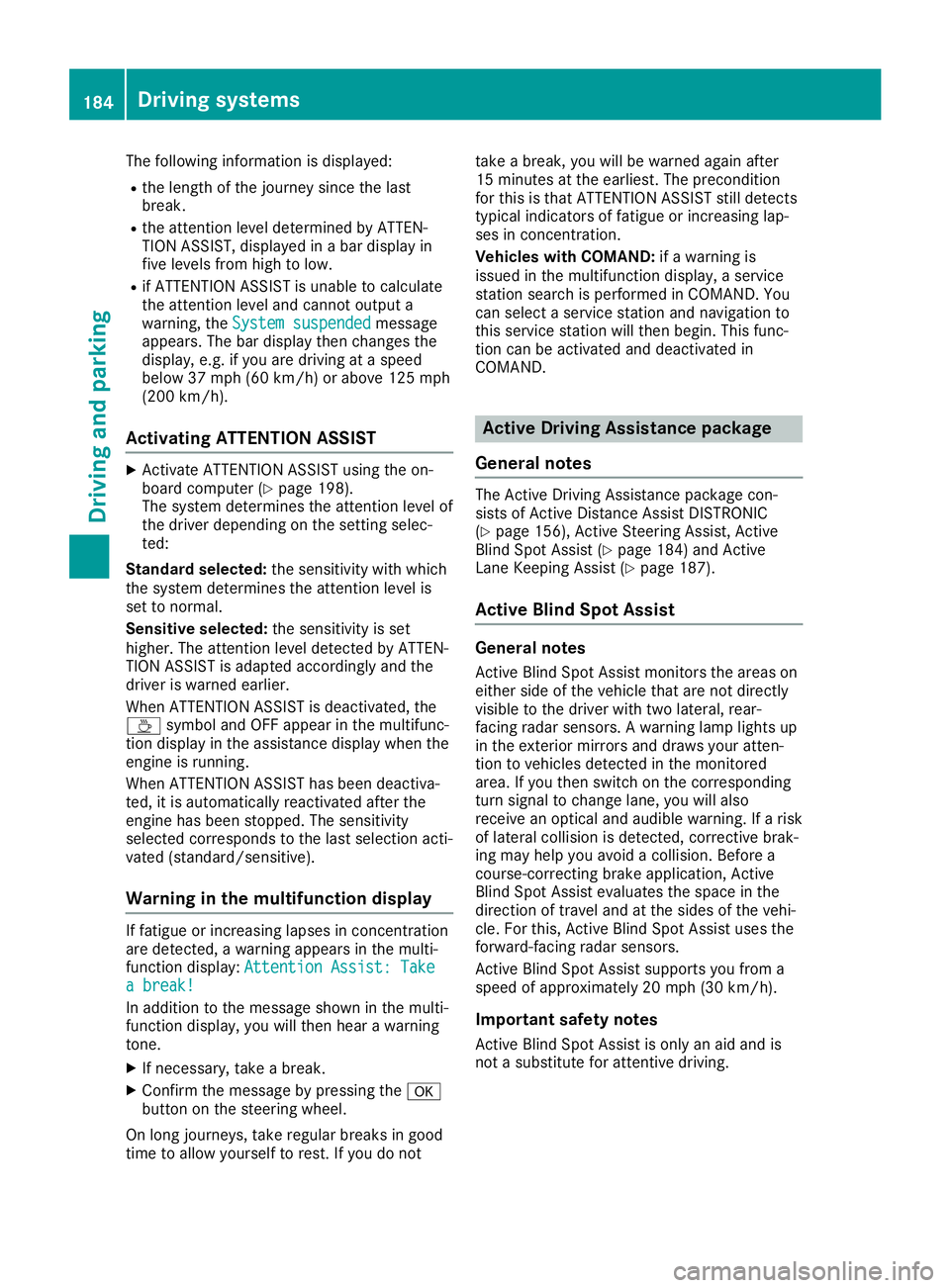
The
following informationisdisplay ed:
R the length ofthe journey sincethelast
break.
R the atten tionlevel determin edbyATTEN -
TION ASSIST, display edinabar display in
five levels fromhightolow.
R ifATTE NTION ASSISTisunable tocalculate
the atten tionlevel andcann otoutput a
warning, theSystem suspended System
suspended message
appears. Thebardisplay thenchanges the
display ,e.g. ifyou aredriving ataspeed
below 37mph (60km/ h)or above 125mph
(2 00 km/ h).
Acti vating ATT ENT ION ASSIS T X
Ac tivat eAT TENTI ON ASSIST usin gth eon -
boar dco mput er(Y page 198).
The systemdeterm inesth eatt ention levelof
th edri ver depe nding ontheset ting sele c-
te d:
St and ardselect ed:thesen sitivit ywit hwhic h
th esyst emdeterm inesth eatt ention levelis
set tonorm al.
Sens itive select ed:thesen sitivit yis set
high er.The attention leveldet ectedby ATTEN-
TIO NAS SIST isadapt edacc ordinglyand the
dri ver iswarn edearl ier.
When ATTENTI ON ASSIST isdeac tivat ed, the
00AD symboland OFFappear inthemult ifunc-
ti on disp layintheassi stanc edisp laywhen the
en gin eis run ning.
When ATTENTI ON ASSIST has been deactiva-
te d, itis auto maticallyreac tivat ed afterthe
en gin ehas been stoppe d.The sensitivit y
sele cted correspo ndsto thelast selection acti-
vat ed (stand ard/ sensitive ).
Wa rning inthemu ltifu nct ion displa y If
fat igue orinc reas inglapse sin concen trati on
are detected, awarn ingappear sin themult i-
fun ction disp lay:Attention Assist:Tak e Att
ention Assist:Tak e
a bre ak! a
bre ak!
In addit iontothemes sage showninthemult i-
fun ction disp lay,you willthen hear awarn ing
to ne .
X Ifne cessar y,tak eabre ak.
X Con firm themes sage bypre ssing the0076
but tonon thest eer ing whee l.
On longjo urn eys, takereg ular breaks ingoo d
ti me toallow yourselftores t.Ifyou donot tak
eabre ak, you willbewarn edagain after
15 min utesat theearl iest.The precond ition
for this isthat ATTENTI ON ASSIST still det ects
typ ical indicat ors offat igue orinc reas inglap-
ses inconcen trati on.
Veh icles withCOMA ND:ifawarn ingis
iss ued inthemult ifunction disp lay,aser vice
st ati on sear chisper formed inCOMA ND.You
can selectaser vicest ati on and navigat ionto
th is ser vicest ati on will then begi n.This func-
ti on can beact ivat edand deac tivat ed in
COMA ND. Acti
veDri ving Assis tance packa ge
Gene ralnot es The
Active Drivin gAs sis tan cepac kageco n-
sis tsof Active Distanc eAs sis tDI ST RONI C
(Y page 156), Active Steer ing Assis t,Ac tive
Bli nd Spot Assis t(Y page 184)and Active
Lan eKee pingAs sis t(Y page 187).
Acti veBlind Spot Assis t Gene
ralnot es
Ac tive Blind Spot Assis tmon itors theareas on
eit her side oftheveh icleth at are notdir ectly
vis ible tothedri ver withtwo lateral ,rear -
fac ing radar sensors.Awarn inglamp lightsup
in theex terio rmir rorsand draw syour atten-
ti on toveh icles det ectedin themon itore d
area. Ifyou then swit chon theco rrespo nding
tur nsign alto chang elan e,you willalso
rec eivean opt ical and audible warning.If aris k
of lateral collisi onisdet ected, correc tive brak -
ing may help youavoidaco llisi on.Be for ea
co urs e-co rrec ting brak eapplic ation,Ac tive
Bli nd Spot Assis teval uate sth espac ein the
dir ection oftravel andattheside sof theveh i-
cle .Fo rth is, Active Blind Spot Assis tuses the
for ward -facin gradar sensors.
Ac tive Blind Spot Assis tsupp ortsyou from a
spee dof appr oximat ely20mph (30km/h).
Imp ortant safety notes
Ac tive Blind Spot Assis tis on lyan aid and is
no ta subs titut efor attentive drivin g. 184
Driv
ingsystem sDriv ingand parki ng
Page 206 of 330
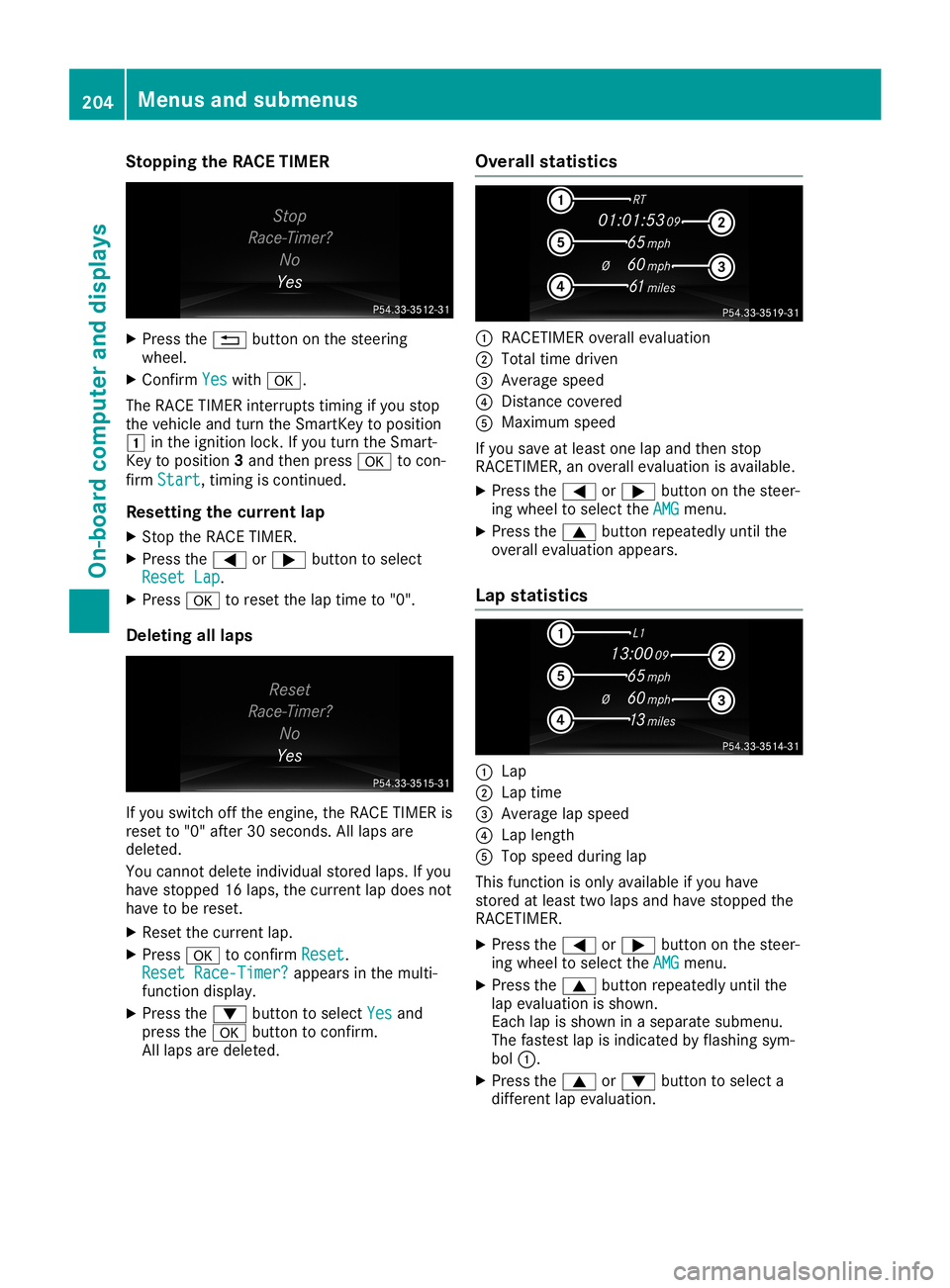
Stopping
theRACE TIMER X
Press the0038 button onthe steering
wheel.
X Confirm Yes Yes
with 0076.
The RACE TIMER interrupt stiming ifyou stop
the vehicle andturn theSmartK eytoposition
0047 inthe ignition lock.Ifyou turn theSmart-
Key toposition 3and then press 0076tocon-
firm Start Start,
timingiscont inued.
Resetting thecurrent lap
X Stop theRACE TIMER.
X Press the0059 or0065 button toselect
Reset Lap Reset
Lap.
X Press 0076toreset thelaptime to"0".
Dele ting alllaps If
you switch offthe engine, theRACE TIMER is
reset to"0" after 30seconds. Alllaps are
deleted.
You cannot deleteindividual storedlaps.Ifyou
have stopped 16laps, thecurrent lapdoes not
have tobe reset.
X Reset thecurrent lap.
X Press 0076toconfirm Reset Reset.
Reset Race-Timer? Reset
Race-Timer? appearsinthe multi-
funct iondisplay .
X Press the0064 button toselect Yes Yes
and
press the0076 button toconfirm .
All laps aredeleted. Overall
statistics 0043
RACETIMER overallevaluation
0044 Total timedriven
0087 Average speed
0085 Distanc ecovered
0083 Maximum speed
If you save atleast onelapand then stop
RACETIMER, anoverall evaluationisavaila ble.
X Press the0059 or0065 button onthe steer-
ing wheel toselect theAMG AMG
menu.
X Press the0063 button repeatedly untilthe
overall evaluationappears.
Lap statistics 0043
Lap
0044 Lap time
0087 Average lapspeed
0085 Lap length
0083 Top speed during lap
This funct ionisonly availa bleifyou have
stored atleast twolaps andhave stopped the
RACETIMER.
X Press the0059 or0065 button onthe steer-
ing wheel toselect theAMG AMG
menu.
X Press the0063 button repeatedly untilthe
lap evalua tionisshown.
Each lapisshown inaseparate submenu.
The fastest lapisindicated byflashing sym-
bol 0043.
X Press the0063 or0064 button toselect a
different lapevalua tion. 204
Menus
andsubmenusOn-board computerand displays
Page 286 of 330
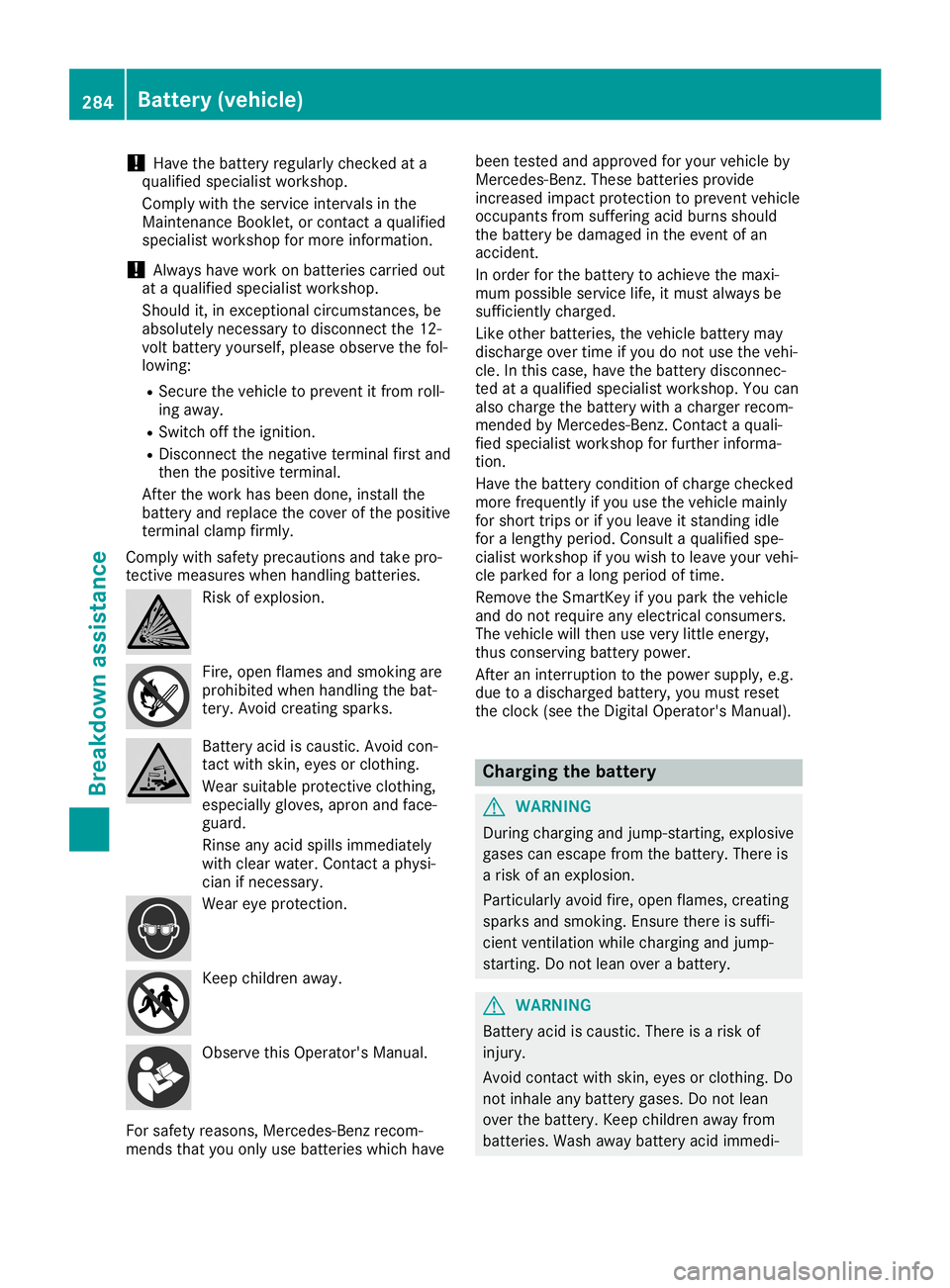
!
Have
thebattery regularlychecked ata
qual ified speciali stworkshop.
Comply withtheservice intervals inthe
Maintenance Booklet,orcont actaqual ified
speciali stworkshop formore information.
! Alway
shave work onbatteries carriedout
at aqual ified speciali stworkshop.
Should it,inexceptional circumstances, be
absolu telynecessary todisconnect the12-
volt battery yourself,please observe thefol-
lowing:
R Secure thevehicle toprevent itfrom roll-
ing awa y.
R Switch offthe ignition.
R Disconn ectthe negative terminalfirstand
then thepositive terminal.
After thework hasbeen done, install the
battery andreplace thecover ofthe positive
terminal clampfirmly.
Comply withsafety precautions andtake pro-
tect ivemeasures whenhandling batteries. Risk
ofexplosion. Fire,
open flames andsmoking are
prohibited whenhandling thebat-
tery. Avoid creating sparks. Battery
acidiscaustic. Avoidcon-
tact with skin, eyesorclothing.
Wear suitabl eprotective clothing,
especial lygloves, apronandface-
guard.
Rinse anyacid spills immediately
with clear water. Contact aphysi-
cian ifnecessary. Wear
eyeprotection. Keep
children away. Observe
thisOperator's Manual.
For safety reasons, Mercedes-Benz recom-
mends thatyouonly usebatteries whichhave been
tested andapproved foryour vehicle by
Mercedes-Benz .These batteries provide
increased impactprotection toprevent vehicle
occupants fromsuffering acidburns should
the battery bedamage din the event ofan
accident.
In order forthe battery toachieve themaxi-
mum possible servicelife,itmust alwaysbe
sufficiently charged.
Like other batteries, thevehicle battery may
discharge overtime ifyou donot use thevehi-
cle. Inthis case, havethebattery disconnec-
ted ataqual ified speciali stworkshop. Youcan
also charge thebattery withacharger recom-
mended byMercedes-Benz .Contact aqual i-
fied speciali stworkshop forfurther informa-
tion.
Have thebattery condition ofcharge checked
more frequently ifyou usethevehicle mainly
for short tripsorifyou leave itstanding idle
for alengthy period.Consult aqual ified spe-
cialist workshop ifyou wish toleave yourvehi-
cle parked foralong period oftime.
Remove theSmartKey ifyou park thevehicle
and donot require anyelectrical consumers.
The vehicle willthen usevery little energy,
thus conserving batterypower.
After aninterruption tothe power supply,e.g.
due toadischarged battery,youmust reset
the clock (seetheDigital Operator's Manual). Charging
thebattery G
WARNING
During charging andjump-startin g,explosive
gases canescape fromthebattery. Thereis
a risk ofan explosion.
Particularl yavoid fire,open flames, creating
sparks andsmoking. Ensurethereissuffi-
cient ventilation whilecharging andjump-
starting. Donot lean over abattery. G
WARNING
Battery acidiscaustic. Thereisarisk of
injury.
Avoid contactwith skin, eyesorclothing. Do
not inhale anybattery gases.Donot lean
over thebattery. Keepchildren awayfrom
batteries. Washawaybattery acidimmedi- 284
Bat
tery (vehic le)Breakdown assistance